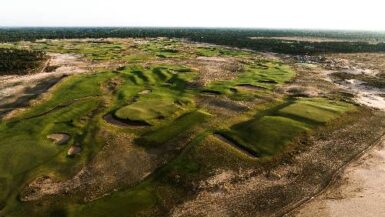
While I work on an article about Lawsonia, here’s some more on Bulls Bay.
ON THE COURSE
What was once an old tomato field with one foot of elevation change over the course of 200 acres has been completely transformed into a majestic, tumbling landscape of broadly sweeping fairways, eye-popping waste bunkers – bunkers so other-worldly they have drawn myriad comparisons to Pete Dye’s Whistling Straits – and fiendishly contoured greens with enormous swales. Treeless, and thus open to the fickle, swirling winds of the ocean, the course plays differently everyday. You could play Bulls Bay your whole life and never get bored.
Moreover, with open fronts to many greens and shaved chipping areas around the green complexes a la Pinehurst, there are a wide variety of greenside options. Putt from sixty yards, bump and run, pitch and check, lob it to the hole, all are options and players may confuse themselves in the clutch as to which shot is the right one to select. Even the same shot will play differently from day to day. Nevertheless, right at the stick is almost never the play.
Mark Bryan, guitar and mandolin player for Hootie and the Blowfish loves the greenside options, especially his putter. “Shoot, I’ll putt from forty yards out and love it” he says eagerly. “It keeps it out of the wind” he adds.
The course eschews the tired, boring “doctrine of symmetry” where each nine must have two par-3 and two par-5s and read 36-36-72. Instead Strantz built five par-5s and five par-3s with an asymmetric 37-35 routing. Moreover, the course not only returns to the clubhouse at nine and 18, but at the par-3 14th as well, which has its own natural amphitheatre for spectators. “It’s what the land dictated” Strantz noted when interviewed in 2004.
Mark Bryan of Hootie and the Blowfish added, “It’s a unique design and everyone here is so supportive of each other. It’s a truly wonderful sense of community with no stuffiness.”
The par-5s and the par-3s not only provide great variety in the routing, they are the most memorable holes on the course. Again showing us something we’ve never seen before, Strantz horseshoed the par-5 second hole around a large tidal lagoon, cunningly setting up the green to accept short wedges from the correct angle, but angled to be difficult to hold by bold players trying to reach in two.
Strantz then counterpunches with the shortest, but most devious hole on the course. The short par-3 third looks like a pushover from the tee, but as course owner Joe Rice notes, “with sharp fall offs and swales around the green, it’s a much tougher par than it looks if you miss your target.” “It’s the number 17 handicap hole on the course, but it played harder than any other hole on the golf course in the tourney last year.” A nasty narrow trench bunker may require an unplayable lie if a player misses short and right.
We get the same “point-counterpoint” mix of par-5, then par-3 at six and seven. Strantz loved Pete Dye’s design features and alternate shot patterns are a staple of both Dye and Strantz holes because they keep players from getting into a groove hitting the same shot over and over. To hit the green in two at the par-5 sixth, draw off the tee, fade into the green is the play. A long, figure eight green sits near a sharply leaning left slope off a huge hill. If you are right of the green, there is no way to keep the chip on the putting surface.
The par-3 seventh may be the prettiest of the par-3s. With wood planks buttressing the green, a lake guards the left, a waste bunker with a gorgeous specimen tree sits well to the right, but those fearing the water often end up in the trap and have to play their next shot towards the water they tried to avoid in the first place. The front ends with a great par-4 playing to a green elevated three clubs above the fairway. Severe slope from left to right with a gargantuan swerving swale kick every ball towards the clubhouse.
After a a modified semi-Biarritz at the par-4 11th where if you are on the wrong section of the green, there is no chance to two putt. “That’s the story of this course” notes Bryan after he three-putts from 100 feet – we come to the most irreverent hole on the course.
My girlfriend once said “when it comes to relationships, nobody’s perfect, and if they are, then that’s their flaw.” Similarly, even Bulls Bay, supermodel of a golf course that it is, has a beauty mark and it is 12. This puny, bratty, smarmy bawdy-winking, mascara-wearing harlot of a par-3 is responsible for more snarled expletives than you’ll hear at an NFL football game. With its heaving sea of sand and serene pond running around the bunkers, it’s pretty all right, pretty until you hit in a hazard and then becomes a gnarled little grinning garden gnome giving you the finger. Oh well, the Mona Lisa has no eyebrows either and no one complains.
For those that need soothing after the excitement of twelve, tough noogies, because thirteen is perhaps the best and toughest hole on the course. Another horseshoe par-5 that needs to herculean and laser perfect shots to hit in two, “It’s one of the most remarkable and unique holes I have ever seen anywhere,” says Mark Bryan admiringly. “I know you can say that about a lot of holes out here, but this one is especially tough, one of the hardest and I respect that. It requires my three best shots and then after all that the adventure is not over since the green has an enormous cant from one section to the other, breaking hard back to the water, maybe ten feet or more. If you’re on the wrong sector, you’re guaranteed a three putt.”
Eighteen is, like any great 18th hole, a summation of all that has come before. On this long par-4 your best drive of the day is followed by a severely uphill approach to a green surrounded by penal waste bunkers and set in the amphitheatre set directly below the clubhouse. Even on ordinary days, players congregate and cheer each others’ approaches on 18, but for the Hootie, the veranda, rocking chairs and amphitheatre are crowded with well-wishers.




